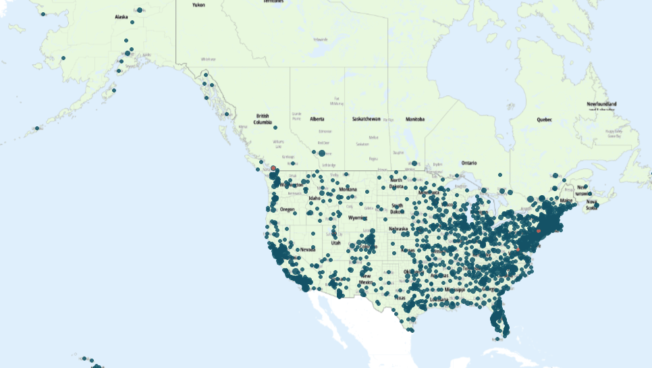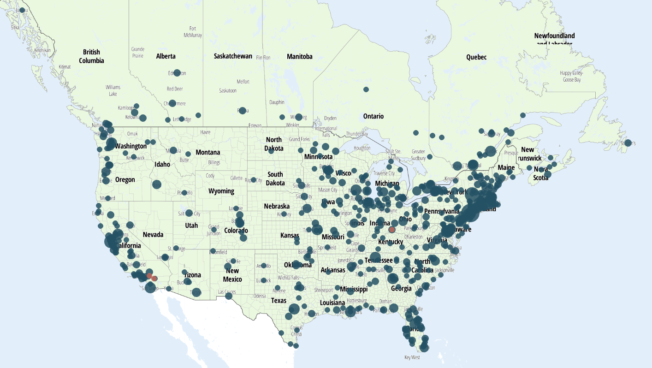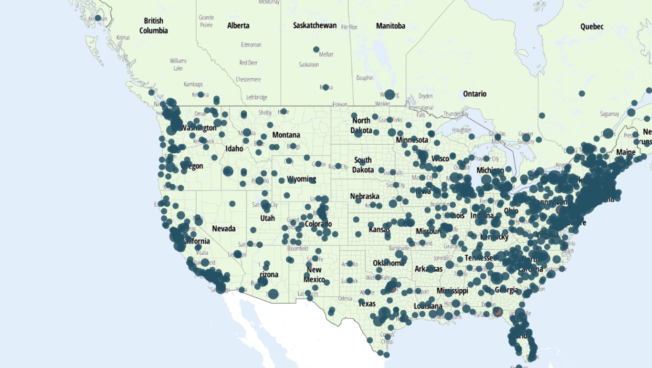Regional Overview
United States & Canada
July 2025
Posted: 4 July 2025
In this Regional Overview covering June 2025:
Demonstration trends
This section provides key figures on demonstration events, which includes incidents categorized as 'Protests,' and 'Violent demonstrations' as recorded by ACLED. For more information on event and sub-event types, see the ACLED Codebook
United States
2,465 demonstration events
130% increase
compared to last month1This Regional Overview covers ACLED data through 27 June. Data for 28-30 June will be available 9 July.
Canada
115 demonstration events
1% increase
compared to last month
United States: ‘No Kings’ demonstrations create largest day spike in events
June saw the second-highest number of demonstrations in a single month — behind only June 2020, the height of the Black Lives Matter movement, following the murder of George Floyd — since ACLED began collecting US data in 2020. This enormous wave of demonstrations stemmed largely from the “No Kings” demonstrations on 14 June, which denounced President Trump’s policies and what demonstrators described as a slide toward autocracy. This day of mobilization immediately followed a smaller spike in demonstrations in response to Immigration and Customs Enforcement (ICE) operations in Los Angeles on 6 June. The No Kings demonstrations, which were organized on the same day as the US Army’s 250th Anniversary Parade and President Donald Trump’s 79th birthday, resulted in the largest number of demonstrations in a single day — over 1,500 — since ACLED began recording data in the United States. This spike surpassed the previous single-day high, which was set just two months prior when many of the same groups that organized the No Kings demonstrations organized the “Hands Off” day of action, also with a message of opposition to the Trump administration.
The vast majority of No Kings demonstrations were held unopposed, with fewer than one in 10 met with counter-demonstrations. The majority of these opposing groups showed support for Trump as well as opposition to immigrant rights. However, some of these counter-demonstrations occurred within a fiercely oppositional climate that increased the chances of demonstrators from both sides carrying firearms. The presence of armed demonstrators and counter-demonstrators at No Kings demonstrations marked the highest single day of armed demonstrations since the height of Black Lives Matter in the summer of 2020.
Militia groups also participated in counter-demonstrations against the No Kings protests in Florida and Texas. In Florida, Proud Boys participated in four counter-demonstrations in Miami, Ocala, Tampa, and Venice. Meanwhile, This is Texas Freedom Force members also participated in a counter-demonstration, claiming they were present to protect historical landmarks in San Antonio. June marks this group’s first appearance since September 2023.
Despite the presence of such groups, the overwhelming majority of counter-demonstrations saw no violent interactions between opposing groups. Still, in one case where violence did occur, there were deadly results. In Salt Lake City, Utah, an armed individual who participated in a No Kings event as a volunteer “peacekeeper” shot at another armed individual who was not part of the demonstration, injuring him and also killing a nearby protester. Though eyewitnesses and police initially claimed the individual was brandishing his weapon at demonstrators, footage released days later appeared to challenge that narrative.2Chris Boyette and Holly Yan, “Utah ‘No Kings’ protest: What we know about the fatal shooting,” CNN, 21 June 2025 The armed individual has been released as a result of this ambiguity, and it is unclear whether he or the peacekeeper will face charges. The national 50501, one of the organizers of the No Kings demonstrations, had mandated that volunteer peacekeepers were to be unarmed. As a result of the incident, it broke ties with the local Utah 50501 branch.
Radical group trends
This section provides key figures on far-right and white nationalist groups.
Far-right groups:
ACLED uses this term to refer to a variety of actors, from 'traditional' militias to militant street movements. Though they are also analyzed separately, this figure also accounts for white nationalist and neo-Nazi groups.
White nationalists:
ACLED uses this term to refer to groups that openly describe themselves as white nationalist, white supremacist, or neo-Nazi.
58
events, of which 43 involve white nationalist groups
15
radical groups active, of which 6 are white nationalist
Radical groups were most active in Montana
White nationalist groups were most active in Texas
United States: ‘Lone Wolf’ violence a looming concern in the US
On 14 June, a man disguised as a police officer, driving a black SUV outfitted with emergency lights, traveled to the homes of four separate Minnesota lawmakers in the suburbs of Minneapolis to carry out a series of attacks. In Champlin, he shot State Senator John A. Hoffman and his wife Yvette, though both survived after receiving medical attention, while in Brooklyn Park, he murdered State Representative Melissa Hortman and her husband Mark. He failed to carry out shootings at the homes of the other two lawmakers as one was not at home, and he spotted police checking in at the home of the other.3Seteve Karnowski et al., “The man suspected of shooting 2 Minnesota lawmakers is in custody after surrendering to the police,” Associated Press, 16 June 2025
Police arrested a suspect on the evening of 15 June and took him into custody. Though Minnesota Governor Tim Walz referred to the shootings as a “politically motivated assassination,” the exact details around the shooter’s motivations remain unknown.4Chris Hippensteel et al., “What We Know About the Minnesota Shooting Suspect,” The New York Times, 14 June 2025 However, the killer carried a list of roughly 70 apparent targets that also included medical professionals, Planned Parenthood locations, and community and business leaders.
Hortman’s murder represents the first political assassination of a state legislator since the murder of South Carolina State Representative Clementa C. Pickney during a mass shooting at the Emanuel African Methodist Episcopal Church in Charleston by a white supremacist gunman, almost exactly one decade prior.5Chris Iorfida, “U.S. political violence is landing on the doorstep now, with deadly effect,” CBC News, 19 July 2025 A handful of high-profile attacks on elected officials have taken place in recent years: the assassination attempts against Trump, the attack on the official residence of Pennsylvania Governor Josh Shapiro, and the assault of Paul Pelosi, former US Representative Nancy Pelosi’s husband, at their home in San Francisco. In each of these incidents, violence was carried out by lone actors — though each appeared to have political motivations, none were partisans for the opposing political camp. Each attacker was apparently motivated by his own specific cocktail of sometimes murky beliefs. These attacks are part of a recent, growing trend in violence carried out by individuals with niche or unclear ideologies.6Hannah Allam and Devlin Barrett, “Lack of motive in Trump attack frustrates public, but fits a pattern,” Washington Post, 20 July 2024
Though violence carried out by organized extremist groups has long been a primary focus of ACLED’s research, “lone wolf” attackers have become increasingly prevalent in the US. Less than one month prior to the shootings in Minnesota, on 17 May, a man carried out a suicide bomb attack on a fertility clinic in Palm Springs, California, causing severe damage to the clinic, which was empty. This attack was carried out by a man who supported “anti-natalism,” a belief that procreation is unethical or unjustifiable. Amid an environment of intense political polarization, rampant online radicalization, and easy access to weapons, the risk of lone-wolf violence has rarely been so high.
See More
See the Codebook and the User Guide for an overview of ACLED’s core methodology. For additional documentation, check the Knowledge Base. Region-specific methodology briefs can be accessed below.
Links:
For additional resources and in-depth coverage of demonstration and political violence trends across the US, check our dedicated US Crisis Monitor.







